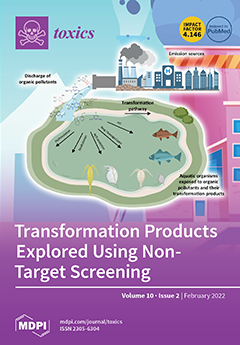The omnipresence of microplastic (MP) in various environmental samples, including aerosols, has raised public health concerns; however, there is presently very limited information on MPs in indoor aerosol. This paper presents a unique dataset where smaller MPs have been sampled using a six-stage
[...] Read more.
The omnipresence of microplastic (MP) in various environmental samples, including aerosols, has raised public health concerns; however, there is presently very limited information on MPs in indoor aerosol. This paper presents a unique dataset where smaller MPs have been sampled using a six-stage cascade impactor from indoor environments in Kuwait. The MP concentration in the indoor air varied between 3.2 and 27.1 particles m
−3, and the relative MP concentration decreased linearly from the lowest to the highest size fraction. A significant effect of location was observed for the total number of MPs (F
2,14 = 5.80,
p = 0.02) and the inhalable fraction (F
2,14 = 8.38,
p = 0.005), while location had no effect on the respirable fraction (F
2,14 = 0.54,
p = 0.60). A significant effect of the type of air conditioning used was also observed for the total number of MPs (F
2,19 = 5.58,
p = 0.01) and the inhalable fraction (F
2,19 = 6.45,
p = 0.008), while location had no effect on the respirable fraction (F
2,19 = 1.30,
p = 0.30). For the total number of MPs and the inhalable fraction, the concentration was significantly higher for the split unit air-conditioning as compared to the central air-conditioning plants. The presence/absence of carpets had no significant effect on the MP concentrations (total: F
1,19 = 4.08,
p = 0.06; inhalable: F
1,19 = 3.03,
p = 0.10; respirable: F
1,19 = 4.27,
p = 0.05). The shape was dominantly fibers, with few fragments in lower size fractions. These datasets represent the first baseline information for Kuwait, and the smaller MPs in all the samples further underscore the need to develop standardized protocols of MP collection in the ≤2.5 µm fraction that can have more conspicuous health implications.
Full article


